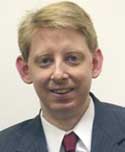UCI to Establish Electron Beam Lithography facility for Nanotechnology Research
By Anna Lynn Spitzer
|
With a $360,000 grant from the National Science Foundation, UC Irvine will establish an advanced lithography research facility in The Henry Samueli School of Engineering to aid emerging nanotechnology work by engineering, physics and chemistry faculty. The grant will be matched by funds from Calit² , the schools of engineering and physical science, and the campus administration. Peter Burke, an assistant professor of electrical and computer engineering and a researcher with Calit², is the lead researcher for the grant project.
The ultra-high resolution electron beam lithography system will foster research in a multidisciplinary environment, allowing UCI researchers to design and process novel materials the size of individual atoms and molecules. These materials will eventually be used for the development of molecular electronics, micro-electro-mechanical systems and biomedical devices, such as a thumbnail-sized "lab on a chip".
|
"This facility is a major advance in UCI's research capacity in the nanotechnology field," said Burke, "and it will allow us to move into whole new areas of work." The lithography system will therefore increase UC Irvine's ability to perform research of interest to industry as well.
Nanolithography employs an electron beam, which can fabricate and write patterns on materials at the scale of 20 nanometers, or roughly the size of a large molecule, such as a single DNA or protein molecule. For example, electron beam lithography can be used to make electrical circuits out of wires and tubes made from chains of molecules. These circuits are being proposed for the development of many molecular-sized technologies, such as biosensor devices that can analyze or mediate the function of systems within the human body.
The ultra-high resolution electron beam lithography system will become part of The Samueli School's Integrated Nanosystems Research Facility (INRF). Additional clean-room facilities will be available in the new Calit² building, scheduled for completion in 2004, and the facilities will be jointly managed. The INRF is directed by G.P. Li, professor of electrical and computer engineering and the Layer Leader of the materials and devices research area within Calit² at UC Irvine. Along with Drs. Burke and Li, other researchers participating in the grant are Abraham Lee, professor of biomedical engineering; Reginald Penner, professor of chemistry, and Wilson Ho, The Donald Bren Professor of Physics and Astronomy and Chemistry.
######



